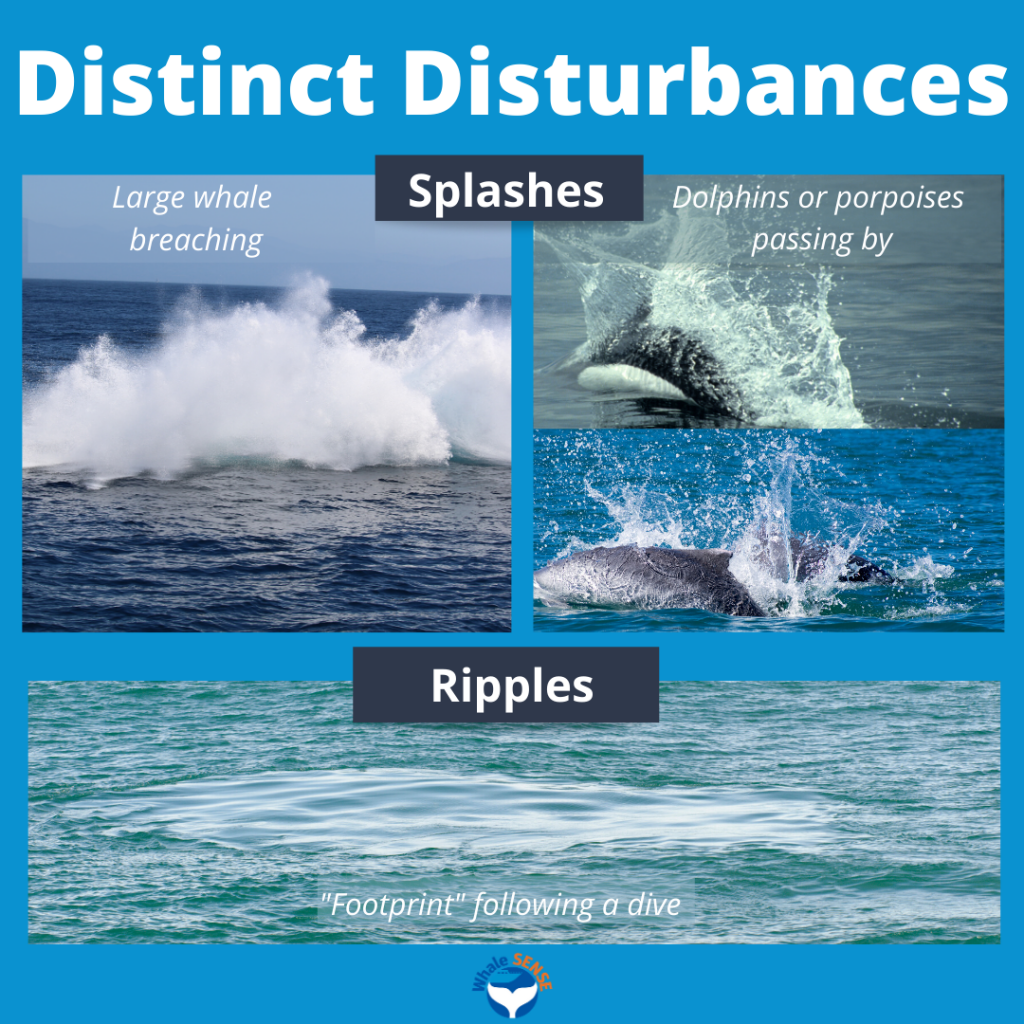Feature image: Naturalist Jon Brink, searching for whales (Photo: Jenna Schwerzmann)
The whole purpose of a whale watch is to see whales, right? But, how do you find them?
The short answer:
The best way to find whales is: To look for them!
It might sound obvious, but since whales are highly mobile and can change their behavior from one moment to the next, it is hard to guarantee where a whale will be. Not to mention, they spend the majority of their life underwater, making them difficult to follow! But, as mammals, like us, all whales have to breathe. When they come to the surface, this is your chance to look for blows, body parts, and splashes!
The long answer:
Spouts, or blows
Similar to when we step outside on a cold day, we can see when a whale exhales. There is a big enough difference in temperature between their breath and the outside air that, for most species, we can see when they exhale. This is called the spout, or blow, and on a good day it can be seen from miles away!
The shape and size of the blow is distinctive to each species, based on the size and shape of their blowhole.

If you see something that looks like a blow, keep watching! Duration between blows can vary from less than a minute, to an excess of 10 minutes, depending on if they went on a dive. So, keep looking in the area that you first saw the whale and watch for other indicators.
Dorsal Fins
Many species of cetaceans (another word for whales, dolphins, and porpoises) have dorsal fins or ridges on the top of their body. Following a blow, you are most likely to see a dorsal fin next. The size, shape, and location on their backs may vary.

Tail Flukes
A tail will most often be observed when a whale is going on a dive. If you see a whale’s tail, it likely will be a few minutes before you see it again. The size and shape of it’s flukes (lobes on its tail) is different for each species.

However, some species are not likely to show their fluke on a dive, and instead will make a pronounced arch of their back.
Splashes and ripples
Changes at the surface of the water can sometimes indicate that cetaceans are nearby. Large splashes may indicate that a whale has just breached. Meanwhile, several small splashes or ripples may be the indicator of a pod of dolphins or porpoises. Meanwhile, a large ripple could indicate the displacement of water following the dive of a large whale.

Factors that could influence spotting whales:
Weather
The conditions in which you are whale watching can make a big impact on what you can easily spot. Decreased visibility due to fog or rain can make it difficult to see blows or other behaviors at a distance. Wind can make splashes, waves, or other disturbances hard to differentiate between a whale and water. Glare from directly above can make it more difficult to see blows, while light at an angle may more easily highlight blows.
Time of year
During certain times of year, some whale species are less likely to be where you are. Some whale species have distinct migration patterns, while others may stay more local the majority of the year.
Whale behavior
In contrast to some feeding or surface active behaviors that may bring whales to the surface more often, resting, long dives, or fast travel can make a whale difficult to see or keep track of.
NOT techniques for finding whales:
✘ Sonar. Sonar systems use sound to detect the location of things under the water. While this may seem like a useful tool for locating whales, the truth is that some sonar systems are harmful to whales, and the ones that likely won’t, will detect close range whales that you will very likely see anyway.
The powerful sound waves emitted by the U.S. Navy to detect enemy submarines, are capable of harming whales and would be extremely costly to have on a whale watching boat. However, the sonar system that some whale watching vessels may have are fish finders. These is really only useful for detecting objects directly beneath the vessel.
✘ Chumming the water: Under the Marine Mammal Protection Act, it is illegal to feed any marine mammal! Not to mention, whales are more interested in eating the live stuff, and LOTS of it!
Now go out and find some whales!
A lot of the fun of whale watching is the unexpected nature of it. When leaving the dock, you can never truly know what you are going to see. Each experience will be unique and leave you wanting more!
Read more answers to Frequently Asked Questions here!


